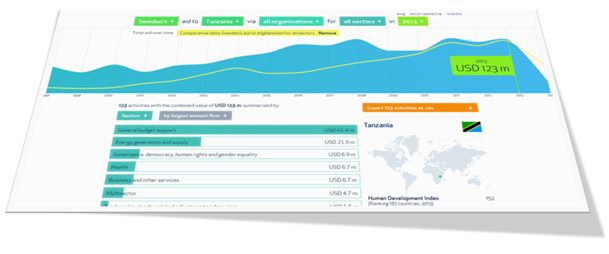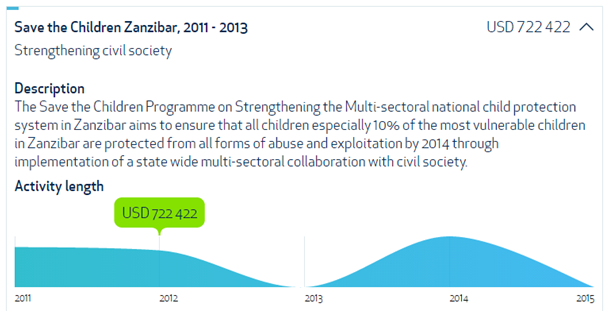The making of Openaid.se
Last week, Sida (Swedish International Development Cooperation Agency) launched a new version of the Swedish aid tracker Openaid.se – showing Sweden’s aid to the world from 1998 to present date. Here is the inside story.
 Sida has been publishing IATI data since 2011, but this is the first time that we are actually “eating our own dog food” in the sense that the data we visualize on the website comes straight from Sweden’s IATI xml-file in the IATI Datastore. This is important not only because it forces us to improve the quality of our IATI data (no aid tracker is ever better than the data it is based on), but it also shows our commitment to aid transparency and the IATI standard.
Sida has been publishing IATI data since 2011, but this is the first time that we are actually “eating our own dog food” in the sense that the data we visualize on the website comes straight from Sweden’s IATI xml-file in the IATI Datastore. This is important not only because it forces us to improve the quality of our IATI data (no aid tracker is ever better than the data it is based on), but it also shows our commitment to aid transparency and the IATI standard.
Furthermore, the web site is built as an open source WordPress theme where you can add any data set from the IATI Datastore. An important choice in the development of the tracker was to build it so that it will work for anyone who publishes IATI data and wants to visualize the data on their own tracker. This means that any aid donor or recipient can make a quick WordPress installation, add the theme and their own data, and be up and running with an aid tracker within hours. At least that’s the idea.
You are also allowed to use parts of the web site and adapt it to your liking (because let’s be honest, some adaptation is probably going to be needed as all countries/organisations are different and have different ways of structuring their work). Even though we haven’t yet posted the details of the project and how to use it, there is already one organisation that has started using parts of it (UNFPA). We will update our “For developers” page on Openaid.se with this information soon, but for now you can contact us at openaid@sida.se if you are interested in finding out more.
![]() Except for making the site “IATI native” and doing everything open source, there is one more thing we have focused on in order to make the new version of Openaid.se a great improvement over the old one. Usability.
Except for making the site “IATI native” and doing everything open source, there is one more thing we have focused on in order to make the new version of Openaid.se a great improvement over the old one. Usability.
First of all we wanted to focus more on the professional user (i.e. people who work within the aid sector and/or with aid data as well as researchers and journalists with a special interest in aid and development cooperation). But at the same time we wanted the basic interface to be ridiculously simple, in order for anyone to be able to use it.
In other words, we didn’t want to make a complex cockpit style interface with hundreds of buttons and sliders to master in order for the user to be able to make the most of the data. Simple and intuitive yet precise and sophisticated were the keywords.
Did we succeed? Well, you be the judge. We chose to structure the top navigation like a sentence which filters the data. It states from who, to whom, via which organisation, for what purpose, and in which year – giving you the basic tools needed to filter the data, which then can be grouped and sorted further down on the page. You can also make a comparison with another such sentence by adding comparative data.
The new Openaid.se presents either a graph that shows data over time or a map that gives a quick geographical overview. Depending on your choice of donor, recipient and organisation you will also be presented with overview data on the donor/recipient/organisation in the right column.
Another function is that you can always choose to view a full list of all the activities, that can range from one to several thousands, depending on your filtering choices. You can also, at any time, choose to download an Excel compatible csv-file containing all the activities.
More information, including a smaller graph, is shown when you dig into the details by clicking on an activity. You can also choose to look at the full activity sheet, where you will also find any document links available at the activity level.
All in all, we are happy with the web site so far, but much work still remains. We will continue to develop the interface, add more information to the “for developers section”, as well as more functionality and visualisations – and perhaps most importantly, continue to improve our IATI data.
 Karl Peterson works at Sida, Swedish International Development Cooperation Agency with aid transparency and Openaid.se. You can contact him and the rest of the Swedish Openaid team at openaid@sida.se.
Karl Peterson works at Sida, Swedish International Development Cooperation Agency with aid transparency and Openaid.se. You can contact him and the rest of the Swedish Openaid team at openaid@sida.se.

